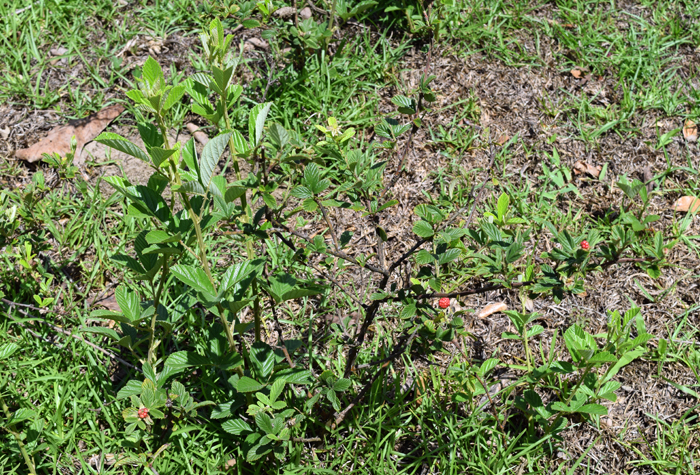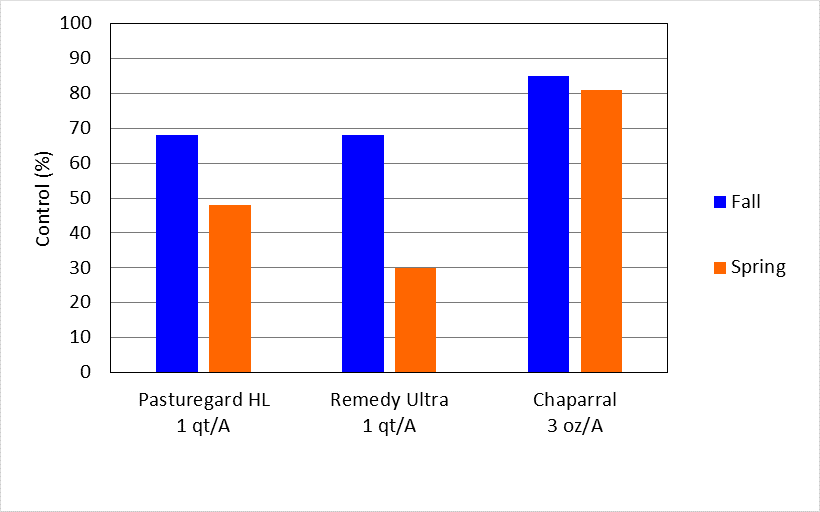Brent Sellers and Jay Ferrell, UF/IFAS Weed Extension Specialists
There are numerous briar or Rubus species (blackberry and dewberry) in the Southeastern U.S., many of which are found in Florida. Blackberry is common in most Florida pastures and can be overlooked for extended periods of time. However, lack of management can give rise to thickets that are difficult to control.
Control
Blackberries are difficult to control, because they are deep rooted, creeping perennials – meaning that as the roots grow, they create new above ground shoots. The shoots, or canes, are biennial as they emerge during the current growing season followed by flowering and fruiting the following season. Their extensive root system stores massive amounts of energy, and must be entirely killed to prevent resprouting. Controlling this large root system is very difficult, so most herbicides provide only marginal control with single applications. In order to maximize herbicide performance, a few precautions should be made.

During fruit development, energy transport is shifted away from the roots, so the herbicide will not be carried down to the roots, resulting in poor control. Credit Brent Sellers
Application Timing
Mid-summer, while most weeds are actively growing, is the time most everyone thinks about pasture weed control. However, blackberry control can be tricky and can fail if not timed properly.
Blackberry is most sensitive to herbicides when blooming or late in the fall. This is because the plant is actively loading energy from the leaves into the root system at these times. Therefore, a herbicide will enter the leaf and immediately be transported to the roots where it is most effective. However, blooming is a relatively short process that soon leads to fruiting. During fruit development, energy transport is redirected away from the root to the fruit. Applying a herbicide at this stage will result in the product staying in the leaves and buds with very little of it ever finding its way down to the root system. A herbicide applied at fruiting will generally cause rapid leaf brown-out, and respouting from the root-stock will typically begin to occur within 2 to 3 months.
Another factor to be aware of is the overall weather conditions during blooming. Dry weather causes the plant to grow more slowly. Therefore, drought will reduce the amount of energy flow into the root system. If herbicides are applied during drought, it is common that the leaf will die before the herbicide can be transported. This means that as the leaf desiccates and falls to the ground, it takes much of the applied herbicide with it.
As stated previously, blackberry control in the spring can be tricky. It is important that you spray at bloom when there is adequate soil moisture. If conditions are dry, or plants are fruiting when you are prepared to spray, it is best to delay the application until the fall, or poor control will result.
Mowing
It is also common to mow blackberry thickets a few weeks or months prior to the herbicide application. Mowing improves the look of the pasture, stimulates grass growth, and causes the blackberry to put on fresh new leaves prior to the herbicide application. However, as stated earlier, it is essential that the herbicide be loaded into the rootstock to achieve effective control. Mowing blackberry stimulates the roots to mobilize stored energy to form new canes and leaves. This naturally causes the energy to travel from the roots to the top of the plant. Therefore, a herbicide application made at this time will not travel downward from the leaf to the roots. Again, a top-kill, or leaf burning will occur, followed by vigorous resprouting.
If mowing has occurred, it is best to delay herbicide application for at least six months. This allows the plant ample time to regrow and restore energy flow from leaves to roots.
Herbicide options
The most commonly used herbicide for blackberry control is triclopyr, which is the active ingredient in several herbicides, including Remedy and Pasturegard. For years the standard use rate of 2 pt/acre of Remedy was recommended. Research at the University of Florida, however, has documented that 1 pt/acre provides similar long-term control of blackberry as 2 pt/acre. The reason for this is that a single herbicide application rarely results in complete control of the creeping root system. Since more than one application is usually necessary for complete eradication of a blackberry infestation, it is best to reduce your application rate of triclopyr to 1 pt/acre to save money for the next application that will likely be necessary. Equivalent control of blackberry with Pasturegard HL can be achieved with 24 oz/acre. An additional option in pastures not planted to bahiagrass is 0.4 oz/acre metsulfuron. Metsulfuron is a slow-acting herbicide that is extremely effective for blackberry control in Bermudagrass fields, but its use is somewaht limited as it causes severe bahiagrass injury. Chapparral is a premixed herbicide blend of metsulfuron and aminopyrilid that also provides good control of briars in Bermudagrass fields.
Comparison of Fall versus Spring Herbicide Application for Blackberry Control
Conclusion
Blackberry is a deep-rooted perennial that is difficult to control under the best circumstances. Therefore, it is critical that steps be taken to maximize herbicide effectiveness. Proper application timing and delayed mowing will not guarantee 100% blackberry control, but it will greatly improve your odds for success. Also, it usually takes several years for a blackberry patch to become noticed as a problem. Therefore, it usually takes more than one herbicide application to eradicate blackberry in any given pasture.
For more information on this subject, use the following fact sheet link:
Blackberry and Dewberry: Biology and Control
- Goatweed Control in Pastures and Hayfields - October 4, 2019
- Thinning the Pawpaw Patch in Your Pastures - May 18, 2018
- Fall Herbicide Applications are Best for Blackberry Control in Pastures - September 22, 2017


